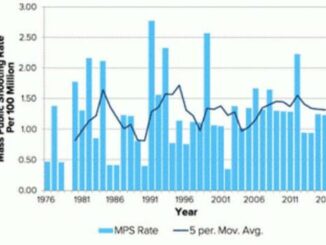
Authored by John Haughey via The Epoch Times (emphasis ours),
The percentage of Americans who think local crime is getting worse hit the highest level in five decades, according to a Gallup poll released on Oct. 28.
A record 56 percent of respondents said they believe there is more crime locally now that there was a year ago.
Nearly four in five (78 percent) said crime increased nationwide since last year, a 33-year-high, according to Gallup, which has conducted the survey every year since 1972.
The Oct. 3-20 random-sample survey of 1,009 adults living in all 50 states and the District of Columbia also found that concern about being a victim of crime has sharply increased since 2021.
The 56 percent who believe there is more crime where they live is 5 percentage points higher than results from the same Gallup poll conducted last year, and 2 percentage points above the previous record set in 1972. More than 28 percent said crime has decreased locally, while 14 percent believe it was the same as last year.
Partisanship and Polls
There are significant variations in the results by partisan affiliation, with 73 percent of respondents who identified as Republicans maintaining they believe local crime has increased, with 51 percent of independents and 42 percent of Democrats in agreement.
The 78 percent who perceive crime is increasing nationwide is 8 percentage points higher than 2021 and matches 2020’s Gallup poll results. The 2022 and 2020 results are the highest since 1992, when 89 percent believed crime had increased the previous year nationwide. About 13 percent said there was less crime and 7 percent believe crime nationwide remained the same from 2021 to 2022.
The same partisan spread is evident in beliefs regarding national crime. More than 95 percent of Republicans–the highest percentage of any group recorded in the annual surveys–said crime is increasing nationwide. Nearly 75 percent of independents and 61 percent of Democrats agreed.
That gap between how more Americans believe crime is increasing nationally than locally is consistent with Gallup polls since it began conducting annual statistical surveys on crime in 1965.
Over that near-60 year span, on average, 44 percent perceive crime has increased locally while an average 67 percent believe crime increased nationwide over the previous year.
Frequent or occasional worry about being a victim of six types of crimes in the survey has increased in the last year, including computer hacking (75 percent) and identity theft (73 percent).
Poll respondents worry least about being assaulted or killed by a coworker on the job (9 percent) or being the victim of terrorism (27 percent).
Perception and Reality
Separating perception from reality in determining if crime has increased over the last year has not been made any easier by the FBI, which has adopted a new system to replace its Uniform Crime Report (UCR), which had been the most comprehensive annual snapshot of crime nationwide since 1930.
When the FBI released its new version of the UCR, the 2021 Crime in the Nation Report, in early October, only 63 percent of the nation’s more than 18,000 law enforcement agencies had submitted their 2021 data, the lowest participation since at least 1979.
Only 52 percent of all agencies submitted a full year’s worth of data, the FBI said. Among those that did not provide any information for the agency’s annual report was the New York City Police Department (NYPD), Los Angeles Police Department (LAPD), and the Florida Department of Law Enforcement (FDLE).
The reason cited by agencies for not submitting data for the FBI’s annual report–which has always been voluntary–is the adoption of its new National Incident Based Reporting System (NIBRS) data-reporting system, which requires greater detail, technical proficiency, and time-consuming effort. This was the first year NIBRS became the only way to submit data to the agency.
After the 2021 data documented across-the-board increases in crime, including a nearly 30 percent increase in homicides in 2020 from 2019–the highest year-over-year increase recorded in FBI history–the FBI has attempted to fill the gaps in a lack of verified data regarding 2021 crime statistics with estimates.
The 2021 Crime in the Nation Report estimates an overall decline in violent crime by 1 percent in 2021 from 2020, driven largely by reductions in the robbery rate, which it estimates declined by 8.9 percent.
The FBI also estimates a 4.3 percent increase in homicides between 2020 and 2021, after the near-30 percent hike between 2019 and 2020.
The Council on Criminal Justice (CCJ), a Washington-based nonprofit that studies criminal justice policy, published a January 2022 study of crime trends across 27 major U.S. cities that found homicides rose by 5 percent and aggravated assaults by 4 percent between 2020 and 2021.
In its mid-year 2022 report published in July, CCJ found homicides had declined 2 percent, but aggravated assaults were up by 4 percent and robberies up 19 percent, from 2021.
AH Datalytics, a New Orleans, La.-based analytics firm which maintains an updated survey of murders U.S. cities with 100,000 or more residents, reported similar findings, documenting 5.7 percent increase in murders between 2020 and 2021. In its mid-year report, AH Datalytics reported a 4.5 percent decrease in murders across the cities it surveys.
Dealing With Crime
The perception that crime is increasing will be on voters’ minds when they cast midterm ballots and the fact that respondents across a slate of October surveys say they believe Republicans are better suited to reduce crime has many GOP candidates highlighting the issue in closing campaign pitches.
Read more here…



